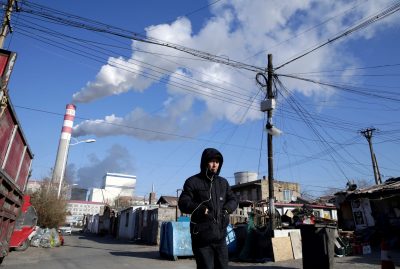China
What carbon neutrality means for the future of coal in China

Authors: Wei Li, Sydney University and Lei Zhang, Yanzhou Coal Mining Ltd
When President Xi Jinping committed China to achieving carbon neutrality by 2060 at the UN General Assembly, this was good news for many, including electric vehicle manufacturers and the renewable energies industries. One sector that stands to lose is the coal industry. The biggest contributor to greenhouse gas emissions in China, thermal coal accounts for almost 60 per cent of China’s energy mix, down from 80 per cent in 1990 and 70 per cent in 2010, but still more than double the global average.
Reducing reliance on coal power will be a major challenge because of its stability as a baseload power source, the relatively young age of China’s coal-fired powerplants, and the country being the largest producer, importer and consumer of coal.
But China’s motivation and ability to shift energy usage away from coal should not be underestimated, as accelerating reforms have shown. Recent coal industry reports coinciding with the gradual release of details from the 14th Five Year Plan confirm that radical restructuring is underway and carbon neutralisation is being rapidly integrated into China’s overall development plan.
State-owned companies carry out most coal mining and power production in China. The coal sector has been tackling overcapacity for a few years already. The number of coal mines shrunk from 12,000 in 2013 to 4700 in 2020, and employment in the coal mining and dressing industry has halved since 2013.
Mergers and acquisitions among state-owned coal mining companies have been encouraged. In 2017, Beijing approved the merger of coal company Shenhua Group with one of the nation’s big five state-owned power generators, China Guodian Corporation. The goal of such mergers and acquisitions is not to expand coal production capacity in China but to enhance cost effectiveness and efficiency.
According to a recent report by the China National Coal Association, ten super-large coal enterprises will emerge out of the consolidation in the next five years, each with an output of 100 million tonnes. Annual coal production will be controlled at a level of 4.1 billion tonnes by the end of the 14th Five Year Plan, compared with 3.9 billion tonnes in 2020. These mergers will allow China to improve national energy efficiency and increase the concentration of power generation.
Besides limiting production expansion and increasing efficiency, China is also slowing down coal consumption. As the government intensifies its war on pollution, the cost advantages of coal as an energy source will gradually shrink. Unlike most other developing countries, China has over the last decade established regulations and regulatory bodies down to the township-government level. This framework will help overcome the lack of enforcement and monitoring at the township level, with the central government forcing local leaders to make better decisions on natural resources usage, including coal.
China’s renewable energy industry is growing faster than capacity in fossil fuels and nuclear power generation. Booming industrial clusters have enabled China’s regional economic centres to emerge as world leaders in renewable energy and technologies such as electric vehicles. China is the world’s largest producer of solar and wind energy. In 2020, slightly less than 30 per cent of Chinese energy consumption came from non-fossil fuel output, including hydropower, wind, solar and biomass. By 2030, China plans to raise its minimum non-fossil fuel power purchase volume to 40 per cent.
Overseas Chinese mining investment is also transitioning away from thermal and fossil fuels to minerals relating to nuclear and renewable energy. In 2020, China Molybdenum acquired a 95 per cent stake in the Kisanfu copper-cobalt project in the Democratic Republic of Congo from US company Freeport. The deposit holds 6.3 million tonnes of copper and 3.1 million tonnes of cobalt. The acquisition will make China Molybdenum a top supplier of cobalt globally in the near future.
Ongoing frictions between Australia and China appear likely to impact seaborne coal shipments, as Chinese importers are somewhat reluctant to place orders for Australian thermal coal. Exports in 2020 were 199 million tonnes, declining by 6.1 per cent compared with 2019. Thermal coal exports to China were zero in January 2021, where average monthly exports were 4.5 million tonnes in the past.
For China, the gap left by Australian coal imports needs to be filled by other countries. Russia is planning to increase coal exports…
China
China’s November 2024 Economy: Navigating Mixed Signals and Ongoing Challenges

In November 2024, China’s economy exhibited mixed results: industrial production rose by 5.4%, while retail sales grew only 3%, below forecasts. Fixed asset investment also faltered. Policymakers are anticipated to introduce measures to stimulate domestic demand and combat deflation.
China’s economy showed mixed performance in November 2024, with industrial production and exports showing resilience, while retail sales and fixed asset investment underperformed, amid ongoing challenges in the property sector. Policymakers are expected to implement targeted fiscal and monetary measures to boost domestic demand and address deflationary pressures.
The National Bureau of Statistics (NBS) has released China’s economy data for November 2024, revealing a mixed performance across key indicators. Retail sales grew by 3 percent year-on-year, a significant slowdown from October’s 4.8 percent growth and well below the 4.6 percent forecast. Industrial production, however, showed resilience, rising by 5.4 percent and exceeding expectations of 5.3 percent growth.
The property sector continued to drag on the broader economy, with real estate investment contracting by 10.4 percent for the January-to-November period, further highlighting the challenges in stabilizing the sector. Fixed asset investment also fell short of expectations, growing by 3.3 percent year-to-date, down from 3.4 percent in October.
In November, China’s industrial value added (IVA) grew by 5.4 percent year-on-year (YoY), slightly accelerating from the 5.3 percent recorded in October. This modest improvement reflects continued recovery in key industries, supported by recent stimulus measures aimed at stabilizing the economy.
The manufacturing sector led the growth, expanding by 6.0 percent YoY, while the power, heat, gas, and water production and supply sector grew by 1.6 percent. The mining industry posted a 4.2 percent YoY increase. Notably, advanced industries outpaced overall growth, with equipment manufacturing and high-tech manufacturing rising by 7.6 percent and 7.8 percent YoY, respectively, underscoring the resilience of China’s innovation-driven sectors.
Key product categories showed robust output gains in November:
From January to November, IVA increased by 5.8 percent YoY, maintaining steady growth over the year despite headwinds from a slowing property market and external uncertainties.
| This article was first published by China Briefing , which is produced by Dezan Shira & Associates. The firm assists foreign investors throughout Asia from offices across the world, including in in China, Hong Kong, Vietnam, Singapore, and India . Readers may write to info@dezshira.com for more support. |
Read the rest of the original article.
China
Ukraine war: 10% of Chinese people are willing to boycott Russian goods over invasion – new study

Since Russia’s 2022 invasion of Ukraine, some Chinese citizens express dissent through potential boycotts of Russian goods, reflecting a complex relationship despite government support for Russia.
Since Russia invaded Ukraine in 2022, the Chinese government has been criticised for its refusal to condemn the war. In 2024, the economic and diplomatic relationship between the two nations appears stronger than ever.
Because of strict censorship and repression imposed by the Chinese Communist Party (CCP), it is difficult to know the extent to which the general public shares their government’s support of Putin’s regime. But a newly published study I carried out with colleagues found that more than 10% of Chinese people surveyed were willing to boycott Russian goods over the war in Ukraine.
This is a surprisingly large figure, especially since existing surveys indicate that Chinese people hold a broadly positive view of their neighbour. We used a representative sample of 3,029 Chinese citizens for this research, to dig into public attitudes to Russia. The survey was done in 2022 after the Ukraine invasion.
We were aware that due to widespread censorship, our participants might not be willing to give honest answers to questions about Russia’s actions in Ukraine. They might also not feel safe to do that in a regime where disagreement with the CCP’s position is often met with harsh punishment. This is why we asked them to tell us if they would be willing to boycott Russian products currently sold in China.
We felt this question was a good indicator of how much the participants disapproved of Russian foreign policy in Ukraine. More importantly, we were also curious to find out whether Chinese citizens would be willing to take direct political action to punish Russia economically for its aggressive behaviour.
In our study, we split respondents into the three different ideological groups in China: “liberals”, who support the free market and oppose authoritarianism; “the new left”, who sympathise with the policies pursued in China under Mao Zedong; and “neo-authoritarians”, who believe the Russian-Ukrainian conflict is an extension of the rivalry between authoritarian China and the liberal United States. These groups were based on the main political beliefs in China.
We found that liberals were most likely to say they were willing to boycott Russian products. Liberals believe that China should work with, rather than against, western democracies. They also place a high value on human rights and democratic freedoms. Because of their beliefs, they are likely to think that Russia’s actions against Ukraine were unprovoked, aggressive and disproportional.
Chinese and Russian economic and diplomatic relations seem closer than ever in 2024.
American Photo Archive/Alamy
The new left and neo-authoritarians we surveyed were more supportive of Russian products. The new left see Russia as a close ally and believe that Nato’s expansion in eastern Europe was a form of aggression. Neo-authoritarians, on the other hand, believe that supporting Russia, an allied autocracy, is in China’s best interest.
Boycotting Russian goods
Asking Chinese participants if they are willing to boycott Russian products might seem like a simple matter of consumer preferences. However, our study reveals a great deal about the way in which regular citizens can express controversial political beliefs in a repressive authoritarian regime.
Boycotting products of certain companies has long been studied in the west as a form of unconventional political action that helps people express their beliefs. However, in the west, boycotting certain products is simply one of many ways people are able to take political action. In a country such as China, boycotting a Russian product might often be the only safe way to express disagreement with the country’s actions.
This is because citizens do not have to tell others they chose not to buy a product, and their actions are unlikely to attract the attention of the authorities.
Since Russian goods are readily available to Chinese consumers and China is encouraging more Russian exports to reach its market, the Russian economy could be significantly affected by an organised boycott campaign in China. The considerable level of support for a boycott expressed by some of our participants, as well as previous acts of solidarity with Ukraine in China, suggest that such a campaign could already be taking place in the country.
This could harm Russia because it regularly exports a number of different products such as meat, chocolate, tea and wine to China. These goods made up 5.1% of China’s total imports in 2023 – and this figure is likely to increase if Russia becomes more isolated from the west, and therefore more dependent on China for its trade.
While 5.1% of the Chinese market might seem like a low figure, China is home to over 1.4 billion people. In this context, even a small boycott could result in a serious loss to Russian companies.
Our research shows that Chinese citizens don’t always support the official position of the communist party. It also shows that many people there will express even the most unpopular political opinions – if they can find a safe way to do it.
This article is republished from The Conversation under a Creative Commons license. Read the original article.
China
Australia Can Enhance China’s Credibility in the CPTPP
In early 2024, China sought to join the CPTPP, potentially offering modest economic benefits to Australia. Key reforms include limiting state-owned enterprise subsidies, enhancing data flows, and banning forced labor.
China’s Interest in the CPTPP
In early 2024, China expressed a keen interest in joining the Comprehensive and Progressive Agreement for Trans-Pacific Partnership (CPTPP), a trade agreement involving eleven Pacific Rim economies and the United Kingdom. This move is anticipated to yield modest economic benefits for Australia. However, it also opens the door for vital reforms in areas such as the control of subsidies for state-owned enterprises, allowing free cross-border data flows, and prohibiting forced labor practices.
Economic Implications for Australia
A May 2024 report from the Australian Productivity Commission indicated that China’s accession to the CPTPP might raise Australia’s GDP by only 0.01%. This modest gain isn’t surprising, given Australia’s existing preferential trade arrangement with China through the Regional Comprehensive Economic Partnership. Nonetheless, the CPTPP encompasses more than just tariff reductions, focusing on broader trade principles and standards.
Reform Commitments Required from China
For China to become a CPTPP member, it must demonstrate adherence to high-standard rules initially developed with the country in mind. This commitment will help alleviate concerns among member nations like Japan and Canada, particularly regarding China’s economic practices and geopolitical tensions, such as those with Taiwan. Membership would necessitate reforms, including limiting SOE subsidies, enabling freer data flows, and banning forced labor, with significant penalties for non-compliance.
Source : Australia can encourage China’s credibility in the CPTPP






